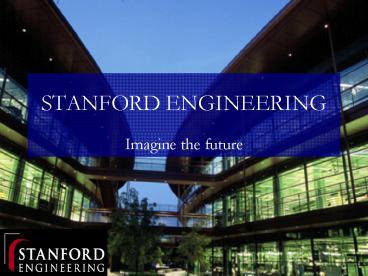STANFORD ENGINEERING - PowerPoint PPT Presentation
1 / 11
Title:
STANFORD ENGINEERING
Description:
National Academy of Engineering (75) Presidential/NSF Young Investigators (42) ... Engineering undergraduates can spend a summer working in graduate research ... – PowerPoint PPT presentation
Number of Views:809
Avg rating:3.0/5.0
Title: STANFORD ENGINEERING
1
STANFORD ENGINEERING
- Imagine the future
2
About Stanford Engineering
- Nine departments
- Aeronautics and Astronautics
- Bioengineering
- Chemical Engineering
- Civil and Environmental Engineering
- Computer Science
- Electrical Engineering
- Management Science and Engineering
- Materials Science and Engineering
- Mechanical Engineering
- 230 faculty, 650 undergraduates, 2950 graduate
students. - Ranked 2 overall engineering school by U.S.
News - 2006 graduate school rankings.
3
About Stanford Engineering
- Faculty/Emeriti Distinctions (number)
- National Academy of Engineering (75)
- Presidential/NSF Young Investigators (42)
- American Academy of Arts and Sciences (33)
- National Academy of Sciences (19)
- National Medal of Science (7)
- National Medal of Technology (4)
- National Institute of Medicine (3)
- Kyoto Prize (2)
- Nobel Prize (1)
4
Stanford Engineering stands out
- Top engineering school within a top university
- Highly ranked schools and depts. including Law,
Medical, Business, Education. - In the heart of Silicon Valley
- Strong record of entrepreneurship and
partnerships in the tech sector. - World class research facilities
- More than 65 labs with state of the art
equipment. - Pioneering professional education programs
- Stanford Center for Professional Development has
served thousands of working, professional
students and hundreds of companies over the last
50 years. - Huge alumni network
- More than 46,000 alumni including 100s of company
founders, CEOs
5
Strategic Initiatives
- Bioengineering
- New discoveries, technologies, and therapies for
human health. - Environment Energy
- Meeting the needs, such as energy, of a growing
world population in an environmentally
sustainable way. - Information Technology
- Research ranging from basic science, through
materials and devices, to systems and
applications. - Nanoscience Nanotechnology
- Advancing the science and technology of very
small structures.
6
Multi and Interdisciplinary
Chemical
Civil Enviro
Bio
Management
Enviro
Bio
Mechanical
Nano
Info
Aero Astro
Materials
Computer
Electrical
7
Bioengineering
- Representative facilities and research
- Neuromuscular Biomechanics Lab (Scott Delp)
- Combining experiment and computation to study
human movement. Researchers create models to
analyze muscle function, design new medical
products and guide surgery. - Neuron regeneration with adult stem cells (Karl
Deisseroth) - Research into treating depression, schizophrenia
and autism by guiding how stem cells become
neurons in a key part of the brain. - High-throughput Labs on a Chip (Stephen Quake)
- Technology based on microfabricated silicone flow
channels allows for integrated circuit-like
automation of many life sciences experiments,
such as testing the effects of different inputs
on stem cells.
8
Environment and Energy
- Representative facilities and research
- Global Climate and Energy Project (20 faculty
from 5 depts.) - GCEPs 3 objectives Identify research on low
emissions, high-efficiency energy. Identify
barriers to applying these technologies. Research
technologies to overcome barriers and accelerate
application. - Clearing the Air (Mark Jacobson)
- Sophisticated computer models of air pollution
and key insights into wind power, climate change
and the health benefits of zero-emission energy. - Water cleansing biotechnology (Craig Criddle)
- Criddles research includes cleaning up
pollutants such as uranium, nitrates and chromate
using bacteria and other microorganisms.
9
Information Technology
- Representative facilities and research
- Stanford Artificial Intelligence Lab (Sebastian
Thrun) - Teaching machines to reason. Projects include
robots such as an autonomous (self-driving) car
and a generally intelligent household robot that
can assist the disabled and elderly. - Nanoscale and Quantum Photonics (Jelena Vuckovic)
- Toward optical computing building and
integrating light sources, waveguides, filters,
modulators and other devices on a photonic
crystal chip. - Enhanced GPS (Per Enge)
- Augmenting the Global Positioning System with
error correction and interference reduction to
make astoundingly accurate navigation systems.
10
Nanoscience and Nanotechnology
- Representative facilities and research
- Stanford Nanofabrication Facility (Yoshio Nishi)
- A well equipped, 10,500 square-foot,
vibration-isolated class 100 cleanroom used by
600 members from academia, industry and
government. - Carbon nanotube transistors (H.S. Philip Wong)
- When standard silicon transistors become too
small, nanotubes have the potential to keep
Moores Law going. - Self-assembly of nanoscale structures (Zhenan
Bao) - With a little guidance, biological and chemical
processes can assemble materials into intricate
and useful electronic structures without onerous
and expensive lithography.
11
Other key priorities
- Stanford Institute of Design (David Kelley)
- A place for students and faculty in engineering,
medicine, business, the humanities, and education
to work together to solve big problems in a human
centered way. - A place for multidisciplinary teaching,
prototyping, and research. - The prototypes produced in the institute will
include objects, software, experiences,
performances, and organizations. - Research experience for Undergraduates (Brad
Osgood) - Engineering undergraduates can spend a summer
working in graduate research groups, gaining the
kind of hands-on research experience that can
help them decide upon an engineering major.































